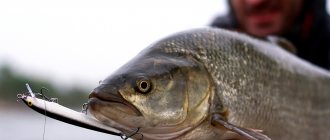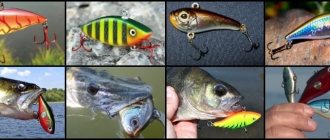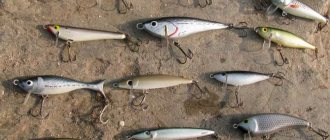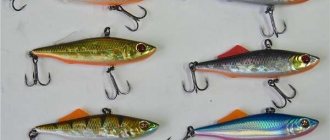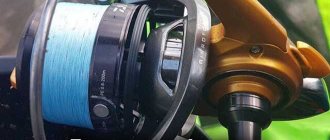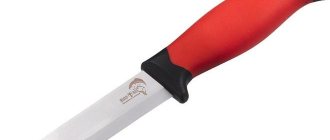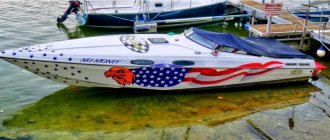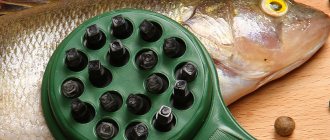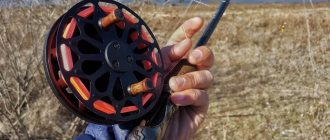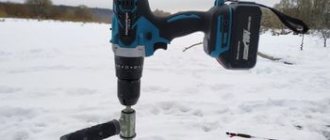Choosing the optimal size
The size of a modern carp hook is determined according to the international classification.
A novice carp angler should be aware that the number assigned to a product is not an entirely accurate parameter and only indicates the approximate size. Products of the same number made by different manufacturers may vary slightly in size. For carp fishing, as a rule, models No. 8–2 are used. The size of the hook directly depends on what baits are intended to be used. For fishing with boilies with a diameter of up to 15 mm, worms or pellets, hooks No. 8 are better suited. If a carp angler uses boilies with a diameter of 18–20 mm, then models No. 4–6 will provide maximum bites. For fishing with larger baits, hooks of at least No. 4 are used.
The size of a modern carp hook is determined according to the international classification. A novice carp angler should be aware that the number assigned to a product is not an entirely accurate parameter and only indicates the approximate size. Products of the same number made by different manufacturers may vary slightly in size.
3.1 Hook with inward eye
This is what this type of hook looks like
What is special about this form? Firstly, it is the most common solution when preparing most carp rigs, and secondly, such a hook is an aggressive comrade that perfectly detects fish, thanks to its ability to turn around when the fishing line is pulled and firmly cling to the lip of the prey. However, they have one drawback - due to their “agility”, when fishing for carp, they greatly tear up the place of the hook, increasing it, which often leads to the fish moving away, since the hook simply slips out.
Read all about fishing leashes: material, types, installation and storage - here
Firstly
It may simply not get into the mouth after the bait, resting against the fish’s lip. Such a single bite will most likely result in a slight movement of the fishing line or may go completely unnoticed, and anglers, as a rule, do not perceive a single signal as a bite.
A larger hook also has more weight, which is very important when catching low-active fish. That is, if the bait is weakly retracted, the hook may simply not get into the fish’s mouth. Of course, the additional weight of the hook can be compensated by the floating part of the bait, but the optimal solution in such a situation would be to reduce the bait and select a hook of the appropriate size.
Hook device
First, let's look at the general design of a single fishing hook.
The main parts are the forend, hook, sting and head or eye; in general, the difference in their design determines the type of hook.
The entire variety of carp hooks can be divided into two types: Wide gape and Curve shank. Their main difference is the shape of the fore-end; the Wide gape has a straight fore-end, while the Curve shank has a curved fore-end. All other carp hooks are made with a focus on one type or another.
Carp hooks are the basis of carp fishing
The main task of a carp hook is to wait for the moment when the carp eats the bait, which is held on to it by the hair. After which it is caught by the lip of the fish. Accordingly, such hooks not only must exist, they simply must be very sharp and reliable.
As for reliability, any fishing hook should have it, and carp hooks especially so. Other properties of hooks (color, size, shape, etc.) already depend on certain fishing conditions.
It follows from this that when choosing a hook for carp fishing, it is necessary that it does not create dissonance with other elements of the equipment. Today in stores there is not just a large selection of hooks, it is simply huge. Because for certain types of fishing, for certain bodies of water, for certain equipment there are different hooks.
FOR EXAMPLE: Classic hooks are great for catching carp on lakes or ponds (where there is no current) with a sandy and rocky bottom. As bait, simple sinking boilies.
Classic hook
This type of hook works great, as they solve the main problem - successfully landing fish and minimizing it coming off the hook.
How the equipment is attached
During hooking, the carp spits out the boilie. Often it is he who can help the carp get rid of the hook. Short hair helps the carp quickly release from the hook, while long hair tangles the equipment, so you need to set up the equipment correctly. The length of the hair should be no shorter than 1 centimeter (ten millimeters).
What size hook should I use?
The diameter of the boilie should be 2 - 3 times greater than the distance from the sharp end of the hook to the shank. The figure shows the values of D and L.
Rigging a classic carp hook
Also, a piece of PVC tube is attached to the hook (in yellow in the picture). Thanks to it, the hook has the correct position when the carp bites, which leads to a successful hook. The length and location of the tube is calculated individually according to the example in the picture above.
You can check whether you did everything correctly by placing the rig on your hand and pulling on the leash. If the hook tries to cling to the skin, then everything is correct. There are also varieties of such hooks with a short shank. Such hooks are one of the best solutions for rigs with the hook turning method. These hooks have shown themselves to be great in rigs for fishing from the bottom.
ANOTHER TYPE OF HOOKS: Hooks with a point curved towards the fore-end are used to avoid snags in places with bottom growth or snags.
Hook with a sting curved towards the fore-end
These hooks do not cling to bottom vegetation so much, but they will not allow the carp to escape when they bite. The equipment here already has a different look. The length of the hair should be approximately 1 millimeter. You simply cannot do without a PVC tube. It adjusts the position of the hook in the carp's mouth. The length, structure and location of the tube are calculated individually using the example in the picture below. The size of the boilie is usually twice the size of the hook.
Curved hook and boilie equipment
Tip: it is better to buy PVC tubes in a store. Do not use heat shrink, as exposure to temperature can damage the leash itself without paying attention to it.
TWO MORE EXAMPLES:
A hook with a bent eye - used in conjunction with rigid leashes so that the equipment is in the correct position and motionless until the carp bites.
Hook with a straight shank - used for catching carp in the upper layers of the reservoir.
a – a hook with a bent eye; b – hook with a straight eye
Coloring
Depending on the feeding habits of carp in a particular pond or lake, the choice of hooks may vary. Food and bottom features can also affect the anatomical features of the fish, which is worth taking into account.
Important! The first carp caught should be carefully examined - this will help determine the shape of the hook and the thickness of the wire, which will ensure a minimum number of escapes.
If the bottom is soft and muddy, and the fish feeds mainly on bloodworms, then its lips will be soft. In this case, preference should be given to hooks made of thick wire. They easily pierce soft lips, but do not cut through them. If the bottom of the reservoir is rocky and the carp’s food is dense, then the lips will be hard. In this case, thin wire hooks help out, as they hook the carp more easily.
Tips for fisherman: How to catch carp with peas correctly - What to choose for fishing
The video will tell you about hooks for carp:
Today, carp hooks with a straight or inwardly curved sting are used, while outwardly curved stings are practically not used.
Hooks for carp
A special feature of a carp hook when used in a hair rig is its openness, which ensures reliable but at the same time relatively safe hooking of fish. When I talk about safety, this is what I mean. that when attaching a bait with a hair, the carp very quickly recognizes the presence of a foreign metal body, and when trying to spit out the bait, the hook clings to the lip. This does not pose a serious threat to the carp, especially when the resulting wounds are treated with a special antiseptic.
Choosing the best carp hook for fishing with a float
We are not talking about those carp hooks that are created specifically for catching trophy fish, for example, with boilies using specialized bottom equipment. We are talking about hooks designed for catching any fish, which are better suited for catching carp.
I like to catch carp with a pole, long cast or a regular fly rod. A special carp plug or “long cast” allows you to successfully fight even pound specimens, but this opportunity appears extremely rarely, so now we are talking about common fishing for fish weighing up to about 3 kg.
The specificity of fishing is that small carp are guaranteed to be seduced not by boilies, but by traditional float baits, such as corn, small food granules, worms, maggots, bloodworms, pearl barley and bread baits.
Based on the baits, it is quite obvious that using powerful powerful carp hooks made of thick wire does not make sense. Such specialized hooks are designed for completely different baits and fish of a different size.
The question arises about what kind of hooks to take from those used for catching other types of fish. In fact, the correct question is: what kind of hook is needed when catching small carp with this or that bait?
Since I catch small carp weighing up to 5 kg dozens of times a season, I think I have the right to share my conclusions.
As an introductory explanation, I would like to clarify that I personally have given up all single hooks except for the hooks of one well-known Japanese company for about ten years now.
The easiest way is to find the right hook for canned corn. Such a hook requires only sharpness and sufficient strength. Even if a thick hook “tears” the bait, then this may be for the best - tasty juice will ooze through the crack and the fish will react faster.
I want to emphasize that if there is no bite for several minutes, then I either plant “fresh” corn, or slightly press the grain on the hook so that the juice comes out. I can safely recommend for such fishing a well-known series called pin hook. These hooks have become so popular that Chinese markets are flooded with fakes.
Universal hook with ring. Photo: Andrey Yanshevsky
The size is selected in such a way that two grains of corn, or a grain with a piece of worm, can be placed on the shank and hook hook.
If you use a worm as bait, which is very important both in early spring and late autumn, then I recommend trying the worm sp-bh model. Well, it’s a very good hook, which I also successfully use when fishing for trout with one and a half inch vibrating tails, or with the same worm.
Hook for worms and for bulky baits. Photo: Andrey Yanshevsky
It is somewhat more difficult to choose a hook for maggots with bloodworms. If carps up to 2 kg bite, then you can safely take chinta or, even better, cut mebaru.
Chinta series. Photo: Andrey Yanshevsky
Reliable cut mebaru series. Photo: Andrey Yanshevsky
It’s worse when specimens of 3-5 kg are periodically pecked mixed with small carp. They are able to straighten these hooks and you need something more powerful.
After many experiments I settled on the tenkara-s model. Previously, I carried out some kind of testing of the hooks. To do this, the hook was clamped in a vice, hooked onto a dynamometer and pulled until the wire began to unbend.
The tenkara-s series is designed for trout fishing, but is excellent for carp. Photo: Andrey Yanshevsky
The result was a conclusion that needed to be tested in practice. The test was more than successful. Moreover, now I no longer have any need to change hooks depending on the attachment or bait - tenkara turned out to be a very universal hook.
But there is one fishing option left in which these hooks are not optimal.
There are cases when carp are so “harmful” that they are tempted by only one “moth” on the hook. In this case, the hook needs to be as light as possible. Light hooks are made from thin wire and in order for the lever to be smaller, you need to take a small hook. So I came up with match sproat No. 14. The hooks in this series are made of special resonant steel.
Hooks for carp: how to choose
The question arises: “What then is the use of a super-reliable hook if it scares away wary carp?” And, conversely, the likelihood that the fish will not notice the catch and take the bait increases if the hook is completely invisible - light, small, on a thin and soft leash. And even without a retainer tube. However, such a hook is easier for the fish to spit out. In this case, the bites are mostly unsuccessful. So look for the “golden mean” - a hook of optimal shape and size.
TOP 5 hooks for carp fishing
The turning point was the release of the Curve Shanx, part of ESP's new Cryogen line of hooks. Hooks are produced using a unique technology that includes extreme temperatures with a plus and minus sign. The result is hooks that are 30% stronger than wire hooks of the same diameter. The only drawback of these hooks is that their incredibly hard steel does not lend itself well to additional sharpening. In principle, they are quite sharp and retain this quality for a long time, so it is not at all necessary to “bring them to mind.”
Forend length
When choosing a hook for carp, the angler should also pay attention to the shank, as it plays an important role in catching this type of fish. When a hook gets into a fish's mouth, it can usually turn around and hook the mouth cavity incorrectly, thereby freeing the fish with one jerk. Therefore, to avoid such a case, the shank of the carp hook should have a long shape.
However, this also has its downsides. The longer the shank of the hook, the more noticeable it is and, accordingly, the combination of a hook with a long shank with unsuitable bait can scare away wary fish.
Hooks for carp fishing come in different shapes. They can be curved or straight. When choosing a hook shape for carp, the angler needs to know the bottom topography where carp fishing will take place. It is believed that hooks with stings concave inside the forend collect less debris at the bottom of the reservoir when reeling in gear. Straight hooks, where the shape of the sting is parallel to the shank, are more suitable for fishing with a sandy bottom of the reservoir.
Bend the hook
For fishing with floating boilies, as well as in zig-rig , hooks with a wide bend are mainly used.
This design provides better hooking due to a larger area of tissue capture on the carp’s lip, which prevents fish from escaping as a result of lip breakage.
However, a wide bend increases the likelihood of the hook breaking when catching large trophy specimens. Products with a narrow bend are more durable.
For fishing with floating
boilies, as well as in zig-rig , hooks with a wide bend are mainly used.
Types of carp hooks
The most common hooks on sale are those with an ear that bends inward. This happens due to the practical degree of versatility of these types of hooks for catching carp. In addition, these types of hooks have the ability to be perfectly combined with various types of carp equipment.
Straight hooks are much less popular, and they are used when fishing for carp on the very surface of reservoirs. These hooks are used in such a way that they are placed directly above the bait itself, but so that the fish does not notice them.
Some fishermen use special devices made from heat-shrinkable tubes, which allows them to lengthen the sting of the hook, increasing the efficiency of the fishing process.
If boilies are used to catch carp fish, then a choice is made in favor of elongated hooks if the boilies have a negative buoyancy value. When fishing with floating boilies, you should choose a hook with a short shank type. If boilies have neutral parameters for their degree of buoyancy, then it is necessary to use closed types of sting at the hook.
Many fishermen who are keen on carp fishing note the fact that not in all cases the more expensive parameters of a hook are indicators of its good level of production quality. Often, less expensive hook variations are more effective and catchy in their parameters.
Some fishermen use special devices made from heat-shrinkable tubes, which allows them to lengthen the sting of the hook, increasing the efficiency of the fishing process.
Selection principles
If you catch carp with a float rod or feeder, where you immediately hook the fish that has bitten with a jerk of the rod, then you can use ordinary hooks, as for other fish. But in carp fishing, the whole point is to hook the carp under the weight of the sinker.
To understand exactly how hooks are selected for carp fishing, you need to understand the entire mechanics of carp biting. To do this, let’s take a virtual look under the water and break down the process into its components.
In order for it to happen as described above, the hook must meet the requirements that were specified at the beginning.
As always, I will not delve into the jungle and long empty opuses. The carp hook should be:
Date: October 25, 2012 | 051
The main thing that distinguishes carp hooks and their use in equipment from all other types of hooks is that the bait (boilies, corn, peas, potatoes, feed pellets, etc.) is not placed on them, but is attached next to them, on special hair. Based on this feature and the fact that large carp is an unusually strong and cautious fish, a number of requirements are built that a product must meet in order to earn the right to be considered a cool carp hook .
Tips for fisherman: Which rod to choose for carp fishing - Answers for beginners
As always, I will not delve into the jungle and long empty opuses. The carp hook should be:
- Durable
- Very spicy
- Unnoticed
- It’s good to hold the fish, it has anti-derailment geometry
All! Any hook that meets these criteria can be safely used in classic carp rigs. And the statement that if it doesn’t say on the packaging that these are special carp hooks , then the hooks really aren’t is bullshit... You can write anything you want. Characteristics are important!
A durable hook means that it is made of high-quality steel; the wire is thick enough; the hook has undergone the correct heat treatment and hardening (it has not been overheated or underheated). Such a hook will meet the characteristics specified by the manufacturer. It will not straighten out and will not break until the specified force is exceeded...
An inconspicuous hook is a dark hook (black, blued). It is necessary that the carp does not see the hook (and for him it is just a foreign object that can alert him, which we don’t want at all...). This means the carp hook should merge with the bottom. If the hook has a matte, non-shiny finish, it will be absolutely perfect!
As for the geometry of carp hooks and the degree of fish retention, it is clear that carp hooks have a medium or long shank, the sting is bent inward and, in general, the hook is somewhat rounded or something... This shape of the hook ensures maximum pressure of the sting on the mouth of the fish, causing it more pain and gives minimal chances of getting off. And the carp, during the fight and fishing, is a true master of the gathering. I have been convinced of this many times...
Everything else is from the evil one. If you want to use carp hooks for $5/piece – no question! “There are no obstacles for patriots,” as they said in the famous DMB film. At least order from gold... But I think that the main thing is a high-quality hook, based on the parameters specified above. This means you can easily find excellent carp hooks in the price range of $0.7-1.5/piece.
Who uses what hooks on the lower Volga? With what attachment, and on what trophy does he place them? Well, about the fishing line, what is the relationship between the size of the hook and the breaking load? Does it exist at all?
Karasev_1
Blocked
danewy
Karasev_1
Blocked
Your main hook is No. 6 according to the international classification, what size fish do you use it for and why this size?
———- Message added at 20:35 ———- Previous message posted at 20:14 ———-
Who uses what hooks on the lower Volga? With what attachment, and on what trophy does he place them? Well, about the fishing line, what is the relationship between the size of the hook and the breaking load? Does it exist at all?
Karasev_1
Blocked
Attachments
danewy
Your main hook is No. 6 according to the international classification, what size fish do you use it for and why this size?
———- Message added at 20:35 ———- Previous message posted at 20:14 ———-
Who uses what hooks on the lower Volga? With what attachment, and on what trophy does he place them? Well, about the fishing line, what is the relationship between the size of the hook and the breaking load? Does it exist at all?
Which hooks are best to choose for carp fishing?
When going fishing, you need to stock up not only with a fishing rod, but also with good hooks, without which successful fishing may not be possible. Today the element is presented in a wide range on the market. There are fishermen who choose carp hooks, others pay attention to "Owner", others like inexpensive products made by "Fugu" or "Cobra". This is all great, but many fishermen are not good at it, so they need to know that the element must be inconspicuous, sharp, strong, and also cling well to the fish.
- Methods for selecting hooks
- Choosing a hook when fishing with boilies
- What size should it be
- Hook sharpness
- How to tie a hook to a fishing line
When fishing with a feeder or float, where the hooking is done quickly and sharply, you must use ordinary hooks that are suitable for catching any other fish. Otherwise, the choice should be approached very carefully. Experienced people who use boilies to attract carp understand that the mechanics of biting are sometimes very difficult, so before choosing hooks you should first pay attention to this point.
Hook selection options
In practice, the best hooks for a feeder are determined empirically. The accepted standard size is important. According to the domestic classification, it determines the distance between the tip and the forend. Fishing hooks vary in size from No. 2.5 to No. 20. Foreign manufacturers are developing their own model ranges and designations.
To select hooks for feeder fishing, you need to study the following characteristics:
- Material of manufacture. Hooks for catching crucian carp are made of high-alloy steel, the surface is treated with an anti-corrosion compound. Recommended color is black or dark blue. You can try fishing with two types to decide on the optimal one.
- Form. The place for attaching the fishing line can be in the form of a spatula or a ring. The first option is used for catching small fish. For large specimens, models with a ring are needed. You can also take two hooks that have a common shank.
- Thickness. The optimal hooks for the feeder are thinner than their standard counterparts. This is explained by the absence of the need to attach a large volume of bait to it.
- Sharpness. For feeder fishing, you need models with maximum sharpness. This parameter needs to be monitored after prolonged use. Deterioration in sharpness will lead to disruption of the catch during hooking.
High-quality hooks for crucian carp are durable, sharp and dark in color. It is important that they are correctly attached to the feeder equipment. It’s better to try the breaking tackle in advance, simulating a bite. To catch large specimens, you need to know which number is suitable for a particular type of fish.
Which coil to choose for a feeder: properties, characteristics, TOP popular models
